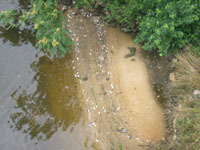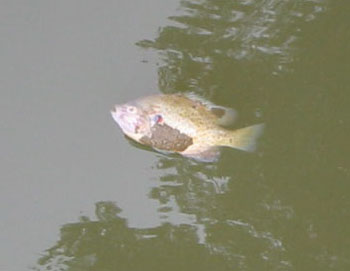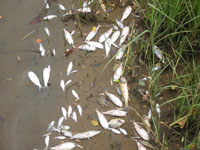|
||||||
An ongoing fish kill of approximately 15,000-20,000 fish was observed on Weems Creek starting on June 28th and continuing into Friday June 29th. The kill was comprised of many species including menhaden, white perch, yellow perch, fundulus, chain pickerel, catfish, and spot. Early indications are that the fish kill was caused by low dissolved oxygen caused by a die-off of an algal bloom of Karlodinium veneficum. Blooms of Karlodinium have been recently observed on the Potomac River near Colonial Beach, VA, Baltimore's Inner Harbor, and throughout many of Maryland's Western Shore tributaries. Karlodinium is potentially toxic to fish, but there is no evidence of human health concerns. Karlodinum has been shown to produce an ichthyotoxin (fish toxn) that can comprise gill tissues of fish and expedite their death in low dissolved oxygen conditions. Officials from MDE and DNR responded to the fish kill and early indications are that bloom levels have decreased on June 29th (about 9,000 cells/ml) versus those observed on the 28th (about 24,000 cell/ml). When blooms of these size die, their biomass is consumed by bacteria which in turn use oxygen in the water column. The depletion of oxygen levels generally begin to stress fish at 5 mg/l or less, and anoxic (<0.2 mg/l) or hypoxic (<2 mg/l) levels can eventually kill fish. Preliminary data from Weems Creek indicates that waters were less than 3 mg/l near the surface and less than 1 mg/l at one meter and deeper, below the surface. Samples have been sent for analysis of exact cell counts and ichthyotoxin levels. This page will update as further information is received.
|




